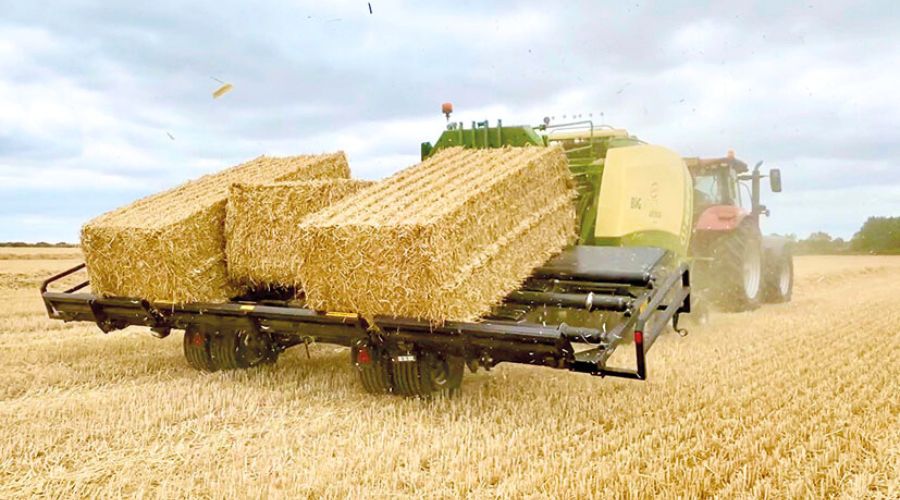A guide to baling safety
24th July 2024
During Farm Safety Week we look back to NFU Mutual’s top tips on staying safe this harvest season, from mowing and baling through to loading and carting, and stacking.

Farmers and contractors must ensure workers are trained and competent in all tasks involved with baling.
Equipment must be safe, maintained, and suitable for transporting.
This includes ensuring trailer floors and end racks are in good condition, as well as any handling equipment is LOLER inspected and the baler itself is fully guarded. Do not allow children to help or be present in bale stacking or moving operations.
Mowing
Before starting mowers up, it’s important for farmers and contractors to check land for any damp areas, given the recent wet weather.
Bob Henderson, head of engineering at NFU Mutual said: “Even if they are familiar with the fields, it is worth finding out about any holes or areas to avoid to prevent breakdowns. Walking the perimeter may be helpful to spot any miscellaneous items such as abandoned tyres. They should also ensure the mowers are set correctly.” Baling
Bob stressed the importance of not overbaling fields by forcing too much crop into the baler. “Crop should also be at the right moisture levels and baled within the recommended speed allowance. Understand the crop type and be vigilant when it comes to fire. Crops can build up under the tractor or machine and catch on fire, dangerously spreading to the machines or the field.”
Bear in mind the terrain, e.g. any gradients or slopes to avoid bales rolling. Additionally, switch off engines and ensure moving parts have stopped before clearing blockages or carrying out maintenance (SafeStop). Make sure greasing is carried out as per instruction to avoid any bearing failures. Even self-greased machines need topping up.
It’s also important to keep well-hydrated, take sufficient rest breaks and carry a charged mobile phone on you at all times – it’s no use to you in the tractor cab. Use the What3Words app to help emergency services find your location.
Loading and carting
When loading bales, Evita Van Gestel, of NFU Mutual Risk Management Services advised: “Load from both sides of the trailer to avoid pushing bales off the edge. Ensure that the loads are built to bind themselves and use sound bales for all outer edges to reduce risk of movement during transport. A falling bale can kill, so keep people clear when loading, including the trailer driver.
“Farmers should properly secure full loads before moving and inspect any sheets, nets or straps for defects before lifting into position.” Take care only to throw the strap across the trailer whilst keeping the buckle in your hand. Also, make sure you load trailers well away from overhead powerlines (at least 10m).
Bob added: “When transporting bales, it is vital farmers and contractors use the right equipment for the right job, such as spikes when moving unwrapped bales or a proper squeezer if wrapped. The machine must also be able to cope with the weight and size of the bale it is moving. For distance, make sure the load is secure and adheres to any weight, height and towing limits for attached trailers.”
Stacking bales
When unloading bales, keep people out of the way and unload from both sides to avoid knocking bales off the far edge by accident, Evita said. Build stacks on firm, dry, level, freely draining ground which should be open and well ventilated. The location should be away from any potential fire hazard and sources of ignition.
Round bales should be stacked in a pyramid shape while square bales must be ‘tied in’ – lower supporting bales are stabilised by overlapping and interlocking upper bales in alternating layers. Wear appropriate personal protective equipment when manually handling bales, including dust masks and gloves.
Evita concluded: “Assess the risks from working at height when stacking and de-stacking bales and select and use appropriate work equipment to do the job safely. Regularly monitor the stack to ensure it remains stable during and after stacking, such as after severe weather events.”
When working at height, overhead power lines should always be a consideration. As such, ProStraw Systems has introduced the AgriPro Line Master high voltage detection system, which can be retro-fitted to a variety of agricultural equipment.
Designed to prevent vehicles and machinery with a variable height from coming into contact with power lines, the system consists of a cab-mounted detection antenna and an in-cab audio/visual warning unit, which can sense the presence of overhead power cables from up to 100 metres away. This warns the vehicle operator of the potential danger of overhead power lines.
Find out more about ProStraw Systems here.
View PJ Reed’s social media for the latest updates.
Read more Farm Safety Week news.


